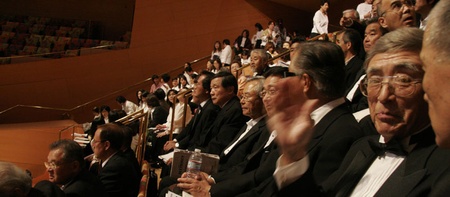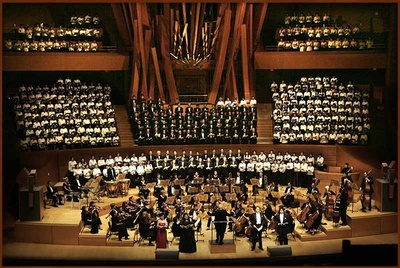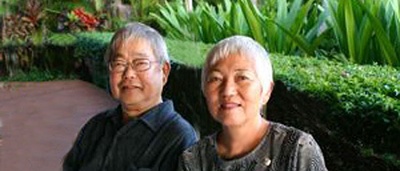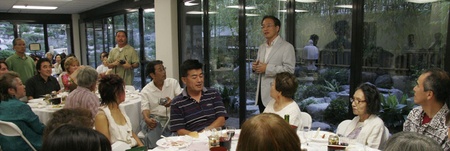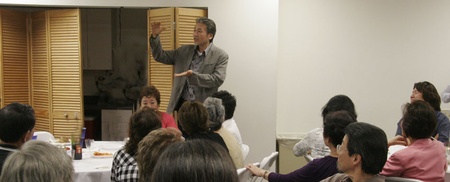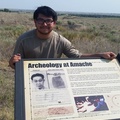>> Part 1
July 10, 2009 – Bridging USA & Japan Concert – Walt Disney Concert Hall
The choir reported to the Walt Disney Concert Hall (WDCH) for the check-in process at 2:00 pm for the 8:00 pm concert. WHY? We learned why. Can you imagine coordinating more than 380 choir singers, considering that, for many, the concert and the visit to the WDCH was a new experience?
We had to be organized so that we could enter the hall according to our seat assignments. At this point, we would again appreciate the concert organizers and volunteers who planned and executed this whole event, from the eight months of choir training and working out the details of putting on a concert, a potential logistical nightmare that turned out to be a dream come true for all of us.
The growing excitement, crescendo-like, was building within each of us as we entered the door to the awesomely beautiful wood-toned music hall. Jim Shunji Shinoda, a retired architectural contractor, recalled attending one of the early concerts in the then brand-new Walt Disney Concert Hall, when Zubin Mehta conducted the L.A. Philharmonic Orchestra performing—guess what?—Beethoven’s 9th Symphony!
As a result of working as a project manager for the United States Pavilion at the 1970 World Exposition in Osaka, Jim Shinoda was assigned to set up a general contracting firm in the United States. He worked on more than sixty projects which included the JACCC building in Little Tokyo where we all learned to sing the chorus that we were about to perform that evening. Shinoda-san had four years of college German, so he, like Max Zerkelbach, could sing in German quite comfortably.
In spite of our early call, the day passed quickly with the flurry of activities. After our practice walk-in to the hall and rehearsal with the orchestra and the soloists, we also practiced the all-important standing in unison at the start of the final movement. Delicious sandwiches and beverages were provided, and we were given pep-talks about adding a smile to our voices as well as to our faces.
At seven o’clock we lined up and prepared to go up the staircase to the rear orchestra level and enter the concert hall. Do we look cool or what?
Since photography is forbidden inside the concert hall, especially during the program, I’ll rely on a beautiful shot taken by L.A. Times Photographer, Ken Hively to show how the choir looked seated with the Asia America Symphony Orchestra and the soloists in place.
We were seated before the audience was allowed to enter at 7:30 pm. Each of us excitedly watched for our family and friends to enter, and from our great seats we could see every section of this beautiful venue. We were all careful to maintain ourselves to match our formal attire, but were thrilled to see the familiar figures of loved ones as they trickled in. I confess that I flicked my white music book in my lap to send a semaphore-like signal and got a positive response.
We had a great view as the Asia America Symphony Orchestra performed four audience-friendly lively and brief pieces before the intermission. I was delightedly surprised that my daughter, Lisa, and grandkids, Chava and Solana, came down to the level where the choir members took their restroom break. It was a joyful reunion, for I hadn’t seen them for over a week. They were so excited with the whole concert experience. All too soon, the intermission was over. I reminded them that our choir wouldn’t sing until the fourth movement and to be patient.
We filed back to our choir positions and sat resolutely through the first three movements of Beethoven’s 9th . I worried a little that my four-year-old granddaughter Solana might be lulled to sleep. I knew Chava would hold up. I later learned that Solana and Chava were enthralled by the whole Beethoven symphony.
Finally, came the familiar opening of the fourth and final movement and the powerful musical passage that cued us to stand. Adrenaline flowed in all our veins as we stood, poised with our music book in hand! Then we heard the strong clear voice of tenor Katsumi Narita stirringly leading us to the now familiar beginning where we would begin our chorus, “Freude . . .Freude!” Then, we were off and running and nothing could stop us. The highs and lows of melodic volume and pace rode like a roller-coaster; then we entered the Prestissimo, which I liken to the tunnel some roller coasters go through, where in the dark, the speed seems impossibly faster. In music “presto ” means fast and “issimo ” means an even higher degree.
At the end of the fun presto ride, we entered Maestoso, the majestic ending that praises “God descended,” and the chorus ends, after which the orchestra dramatically ends the symphony in a brief, but dynamic Prestissimo flurry.
We stood, stunned and mesmerized, as the audience rose as one and erupted in a volcanic ovation that flowed forth over the bowing conductor, bowing soloists, and bowing orchestra members who all gestured towards the choir mass behind them. A generous warm ovation swept over us, and we all just ate it up! I think at that moment, “alle menschen verden bruder ” (brudette)—we felt that all mankind was one!
In the Disney Hall lobby, family, friends, and choir assembled in a bonding mass of mutual admiration, all happy and excited for what we all had experienced together. For all that work, if not for the audience, the performance would have been meaningless.
In addition to my family, Richard and Masako (Koga) Murakami, friends from the Japanese American National Museum, and key and long-time volunteers attended the concert. In fact, Richard loaned me his bowtie. After the concert, Richard and Masako helped to extend my 15 minutes of fame hours more.
The day following the concert, the three choir practice groups held their individual after-concert parties. I can only talk about the DT#9 (downtown, Little Tokyo) group, but I’m sure that getting together again was as joyful for the other two groups as it was for us.
Along with the wonderful camaraderie and great food, we were honored to have the male soloists, Mr. Katsumi Narita and Mr. Jinyoung Jang, as special guests. We also had documentary producer Kerry Candaele attending. Kerry is working on the “Following the Ninth ” video that will show how Beethoven’s 9th Symphony is performed and relevant throughout the World.
Former JBA president, Mr. Yasuyoshi Suzuki, also dropped by to congratulate the choir for the successful performance. He was brief because he was making the rounds of all three choir groups, but he was sincere and kind in his congratulatory remarks. He was also a choir member.
At one point, Mr. Narita, the tenor soloist said, “I have sung the Ninth about 100 times (80 with amateur choruses), and this chorus was among the top class. I heard the chorus for the first time in the joint rehearsal and it was already at a high level and the orchestra was also surprisingly good. The effort showed the commitment of the Japanese community and I was moved by it.”
In the light of that praise by Mr. Narita, we were able to honor our chorus trainers, Ms. Aiko Sakazaki, our voice and language coach, Dr. Hiroshi Taguchi, an accomplished pianist, and our choir manager, Mr. Yasumasa Tanano, for making it possible for us to have such a successful performance and a memorable experience.
In closing, as I’ve said to all who would listen, I was very happy that I took part in this worthwhile and rewarding project. Thanks to the openness of all I have met. I learned so much about the different members of the Japanese community in Los Angeles and discovered that there is a much more diverse and interesting culture within the Japanese National community. So, don’t be hesitant to reach out, engage, and learn that truly, “alle menschen verden bruder .”
Note:
For the Los Angeles Times music critic’s review of the concert, go to the following link: http://latimesblogs.latimes.com/culturemonster/2009/07/david-benoit-and-asia-america-symphony-tackle-beethovens-ninth.html
© 2009 Gary T. Ono




